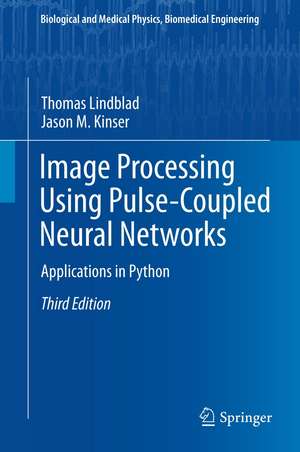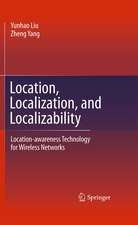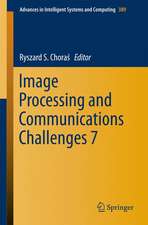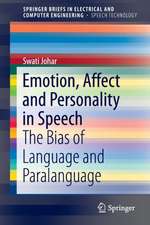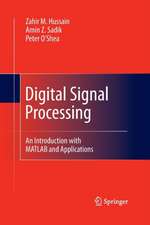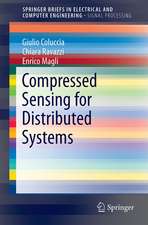Image Processing using Pulse-Coupled Neural Networks: Applications in Python: Biological and Medical Physics, Biomedical Engineering
Autor Thomas Lindblad, Jason M. Kinseren Limba Engleză Paperback – 23 iun 2015
The third edition reflects renewed international interest in pulse image processing with updated sections presenting several newly developed applications. This edition also introduces a suite of Python scripts that assist readers in replicating results presented in the text and to further develop their own applications.
| Toate formatele și edițiile | Preț | Express |
|---|---|---|
| Paperback (2) | 638.76 lei 6-8 săpt. | |
| Springer Berlin, Heidelberg – 23 iun 2015 | 638.76 lei 6-8 săpt. | |
| Springer Berlin, Heidelberg – 14 oct 2010 | 824.71 lei 6-8 săpt. | |
| Hardback (1) | 644.18 lei 6-8 săpt. | |
| Springer Berlin, Heidelberg – 29 mai 2013 | 644.18 lei 6-8 săpt. |
Din seria Biological and Medical Physics, Biomedical Engineering
- 5%
 Preț: 1110.32 lei
Preț: 1110.32 lei - 18%
 Preț: 1006.55 lei
Preț: 1006.55 lei - 18%
 Preț: 960.78 lei
Preț: 960.78 lei - 18%
 Preț: 704.10 lei
Preț: 704.10 lei - 18%
 Preț: 967.40 lei
Preț: 967.40 lei - 18%
 Preț: 948.92 lei
Preț: 948.92 lei - 15%
 Preț: 641.71 lei
Preț: 641.71 lei - 15%
 Preț: 644.95 lei
Preț: 644.95 lei - 15%
 Preț: 665.08 lei
Preț: 665.08 lei - 18%
 Preț: 1669.16 lei
Preț: 1669.16 lei - 18%
 Preț: 941.05 lei
Preț: 941.05 lei - 18%
 Preț: 956.81 lei
Preț: 956.81 lei - 18%
 Preț: 950.21 lei
Preț: 950.21 lei - 15%
 Preț: 636.80 lei
Preț: 636.80 lei - 18%
 Preț: 947.50 lei
Preț: 947.50 lei - 15%
 Preț: 636.80 lei
Preț: 636.80 lei -
 Preț: 397.01 lei
Preț: 397.01 lei - 18%
 Preț: 1236.99 lei
Preț: 1236.99 lei - 15%
 Preț: 644.49 lei
Preț: 644.49 lei - 18%
 Preț: 946.55 lei
Preț: 946.55 lei - 15%
 Preț: 712.22 lei
Preț: 712.22 lei - 18%
 Preț: 952.89 lei
Preț: 952.89 lei - 18%
 Preț: 944.36 lei
Preț: 944.36 lei - 18%
 Preț: 1228.29 lei
Preț: 1228.29 lei - 5%
 Preț: 1422.67 lei
Preț: 1422.67 lei - 18%
 Preț: 1393.27 lei
Preț: 1393.27 lei - 15%
 Preț: 651.19 lei
Preț: 651.19 lei - 18%
 Preț: 953.65 lei
Preț: 953.65 lei - 18%
 Preț: 955.88 lei
Preț: 955.88 lei - 15%
 Preț: 644.95 lei
Preț: 644.95 lei - 5%
 Preț: 1098.48 lei
Preț: 1098.48 lei - 18%
 Preț: 959.19 lei
Preț: 959.19 lei - 15%
 Preț: 643.65 lei
Preț: 643.65 lei - 5%
 Preț: 1165.40 lei
Preț: 1165.40 lei - 5%
 Preț: 1102.67 lei
Preț: 1102.67 lei - 18%
 Preț: 952.09 lei
Preț: 952.09 lei - 18%
 Preț: 946.55 lei
Preț: 946.55 lei - 18%
 Preț: 952.09 lei
Preț: 952.09 lei - 15%
 Preț: 703.20 lei
Preț: 703.20 lei - 18%
 Preț: 953.65 lei
Preț: 953.65 lei - 5%
 Preț: 1008.41 lei
Preț: 1008.41 lei - 15%
 Preț: 644.82 lei
Preț: 644.82 lei - 18%
 Preț: 956.03 lei
Preț: 956.03 lei - 15%
 Preț: 647.40 lei
Preț: 647.40 lei
Preț: 638.76 lei
Preț vechi: 751.47 lei
-15% Nou
Puncte Express: 958
Preț estimativ în valută:
122.26€ • 127.15$ • 102.45£
122.26€ • 127.15$ • 102.45£
Carte tipărită la comandă
Livrare economică 13-27 martie
Preluare comenzi: 021 569.72.76
Specificații
ISBN-13: 9783642440335
ISBN-10: 3642440339
Pagini: 264
Ilustrații: XXIV, 238 p.
Dimensiuni: 155 x 235 x 14 mm
Greutate: 0.37 kg
Ediția:3rd ed. 2013
Editura: Springer Berlin, Heidelberg
Colecția Springer
Seria Biological and Medical Physics, Biomedical Engineering
Locul publicării:Berlin, Heidelberg, Germany
ISBN-10: 3642440339
Pagini: 264
Ilustrații: XXIV, 238 p.
Dimensiuni: 155 x 235 x 14 mm
Greutate: 0.37 kg
Ediția:3rd ed. 2013
Editura: Springer Berlin, Heidelberg
Colecția Springer
Seria Biological and Medical Physics, Biomedical Engineering
Locul publicării:Berlin, Heidelberg, Germany
Public țintă
ResearchCuprins
Biological Models.- Programming in Python.- NumPy, SciPy and Python Image Library.- The PCNN and ICM.- Image Analysis.- Feedback and Isolation.- Recognition and Classification.- Texture Recognition.- Color and Multiple Channels.- Image Signatures.- Logic.
Notă biografică
Thomas Lindblad got his Ph.D. at the University of Stockholm in 1974, became associate professor two years later. Dr. Lindblad started his research career in nuclear structure and particle physics with a special interest in detector systems. He soon became the head of the section for Measuring Techniques and Information Processing at the Manne Siegbahn Institute of Physics. He was a frequent visitor to laboratories in Oak Ridge, Berkeley, Orsay, Grenoble and Darmstadt. Later professor Lindblad took a special interest in teaching, started Environmental Physics at the Royal Institute of Technology, Department of Physics, where he also was the director of undergraduate studies for several years. During this time his research interests focused on sensor techniques of different kinds and feature extraction of torrent data flows. A special interest was always the use of neural network hardware with applications to these fields and to diagnostics and environmental monitoring.
Jason Kinser received a D.Sc. in Optics and Electro-Optical Systems in 1994 and an M.S. in Physics in 1987. He joined Alabama A&M in 1994 as an associate research professor as a founding member of the Center for Applied Optical Sciences. He joined George Mason University in 1997 and is now an associate professor in the School of Physics and Computational Sciences at GMU. He has been a visiting scientist at the Royal Institute of Technology (Stockholm) and the Korean University (Seoul). He has also been a visiting scientist at Lawrence-Berkeley National Lab and an external examiner at the University of Mauritius. His research interests started with optical and image information processing including pulse image processing and now extends into processing of data existing in multiple domains.
Jason Kinser received a D.Sc. in Optics and Electro-Optical Systems in 1994 and an M.S. in Physics in 1987. He joined Alabama A&M in 1994 as an associate research professor as a founding member of the Center for Applied Optical Sciences. He joined George Mason University in 1997 and is now an associate professor in the School of Physics and Computational Sciences at GMU. He has been a visiting scientist at the Royal Institute of Technology (Stockholm) and the Korean University (Seoul). He has also been a visiting scientist at Lawrence-Berkeley National Lab and an external examiner at the University of Mauritius. His research interests started with optical and image information processing including pulse image processing and now extends into processing of data existing in multiple domains.
Textul de pe ultima copertă
Image processing algorithms based on the mammalian visual cortex are powerful tools for extraction information and manipulating images. This book reviews the neural theory and translates them into digital models. Applications are given in areas of image recognition, foveation, image fusion and information extraction.
The third edition reflects renewed international interest in pulse image processing with updated sections presenting several newly developed applications. This edition also introduces a suite of Python scripts that assist readers in replicating results presented in the text and to further develop their own applications.
The third edition reflects renewed international interest in pulse image processing with updated sections presenting several newly developed applications. This edition also introduces a suite of Python scripts that assist readers in replicating results presented in the text and to further develop their own applications.
Caracteristici
Explains how to learn from nature image recognition Applies pulse-coupled neural networks to image processing Displays many applications accompanied by Python scripts Considers a wide variety of image processing applications Includes supplementary material: sn.pub/extras
